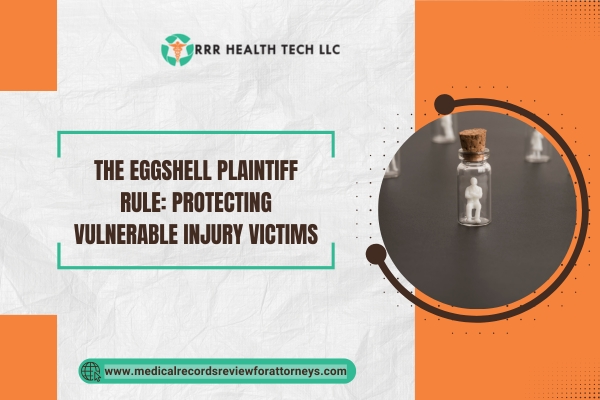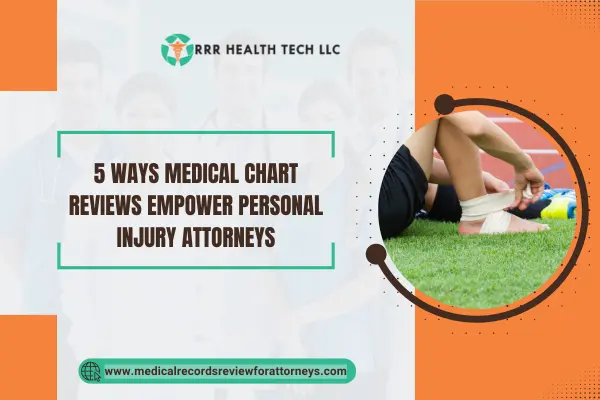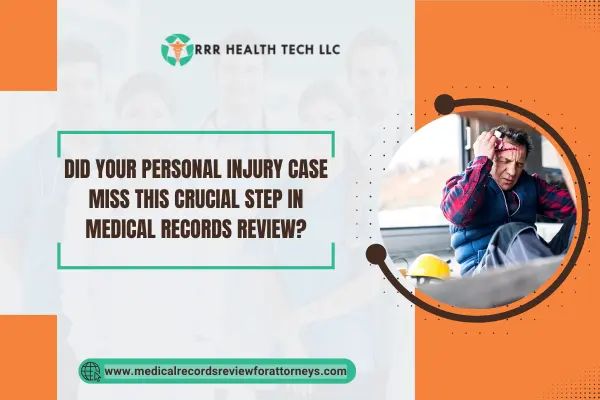
Similar to the Thin Skull Rule, The Eggshell Plaintiff Rule is one of the most important rules in personal injury law that ensures that victims receive the necessary compensation regardless of existing medical vulnerabilities or injuries. This article covers narratives surrounding the eggshell plaintiff rule and its legal consequences, as well as how a medical records review service can help lawyers represent their clients better.
What is the Eggshell Plaintiff Rule?
The principle of the `eggshell plaintiff teaches that a defendant is responsible for the consequences of harm caused to the plaintiff, irrespective of how disproportionate the harm is when compared to the plaintiff’s existing injuries or illnesses. It lies in the heart of these principles that every defendant must face the consequence of not taking care that diligent adults are expected to take.
Important Terms
• Eggshell Plaintiff: Refers to a person with an underlying illness or injury that makes them vulnerable to a higher risk of getting injured.
• Eggshell Skull Rule: The legal rule that stops a defendant from lowering their responsibility because a plaintiff has injuries that make them more susceptible to injuries.
Importance of the Eggshell Plaintiff Rule in Personal Injury Cases
Ensuring Full Compensation
The eggshell plaintiff rule guarantees that defendants cannot evade responsibility for unexpected complications arising from their negligent actions. This principle is vital in personal injury cases, as it ensures that victims receive compensation for all damages incurred.
Preventing Victim-Blaming
The rule protects plaintiffs from being blamed for their vulnerabilities. Courts focus on the defendant’s negligence rather than the plaintiff’s medical history, ensuring that victims are not unfairly penalized for their pre-existing conditions.
Application in Various Cases
• Car Accidents: A victim with a prior head concussion has long-standing cognitive issues due to a car colliding with his bicycle.
• Slip and Fall Cases: An osteoporosis patient walks into a supermarket, slips and breaks their hip.
• Workplace Injuries: An employee in the construction business with arthritis sustains considerable damage to his joints due to falling when equipment he was using malfunctions.
Legal Framework Surrounding the Eggshell Plaintiff Rule
Proving Liability
To establish liability under the eggshell plaintiff rule, the plaintiff must demonstrate:
- Negligence: The defendant fell short of the requisite standard of care.
- Causation: A direct link existed between the negligent step and the damage sustained by the claimant.
- Aggravation of Pre-Existing Condition: There was a previous condition with the individual which was aggravated.
Types of Damages Recoverable
Under the eggshell plaintiff rule, plaintiffs may recover various types of damages, including:
• Medical expenses: Relevant treatments both presently and in the future.
• Loss of income: Earning a living from work that is untaken because of the injury.
• Emotional distress: Pain inflicted by an aggravated condition.
• Social security payments: Covers assistance rendered from continued therapy or surgeries.
The Role of Medical Records Review in Eggshell Plaintiff Cases
Importance of Medical Documentation
Medical records play a pivotal role in establishing the extent of a plaintiff’s pre-existing conditions and the impact of the injury sustained. Accurate and comprehensive medical documentation can significantly influence the outcome of a case.
How Medical Records Review Services Assist Attorneys
- Reasonable Review: Examination of the medical record to determine whether there are conditions in the medical history relevant to the injury.
- Proof of Injury: Providing medical proof that the injury resulted from the defendant’s action.
- Proofs of loss: Helping to put together the claim for medical costs, loss of earnings, and other damages.
Current Trends and Statistics (2024)
- Increase in Personal Injury Claims: In 2024, there has been a notable rise in personal injury claims involving eggshell plaintiffs, reflecting a growing awareness of the rights of vulnerable victims.
- Legal Precedents: Recent court rulings continue to reinforce the eggshell plaintiff rule, ensuring that defendants are held accountable for the full extent of injuries.
Case Studies
Case Study 1: Car Accident with an Eggshell Plaintiff
• Overview: A woman with a chronic history of having bouts of migraines had a vehicle collision which made her migraines worse, leaving her with chronic pain.
• Challenges: In this case, the defense contended that the migraines were already there prior to the accident and were not caused by it.
• Solutions: Analysis of the medical documents proved that after the incident, the plaintiff’s migraine episodes became more frequent and severe in nature.
• Compensation: The plaintiff was given total damages to equal the medical costs, alongside the pain and suffering endured.
Case Study 2: Slip and Fall Incident
• Overview: An elderly gentleman suffering from osteoporotic conditions slipped and fell while shopping in a grocery store, which led to him fracturing his hip.
• Challenges: The store tried to discharge some of its liability by arguing surrounding age and the man’s pre medical condition.
• Solutions: In this case, medical records were analyzed to prove that the man’s fracture was due solely because of the fall and the fracture could not have happened without the negligence of the store.
• Compensation: The victim received recompense for the medical expenses along with expenses for their rehabilitation and pay that was not received due to work absence.
Conclusion
Understanding the plaintiff with pre-existing medical conditions rule helps a personal injury lawyer appreciate the complexities involved in injuries resulting from personal negligence. This rule, alongside the review of medical documentation, enables attorneys to strategically advocate for their clients. Through these methods, lawyers can develop stronger arguments that guarantee their clients are adequately compensated.


